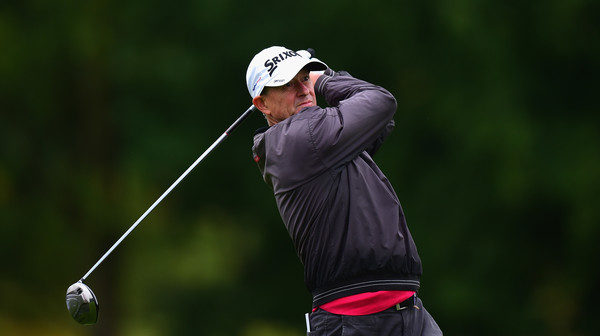Gentlemanly, kind, professional.
Characteristics of a human being dedicated to his craft. His profession was his life and vice versa. But the story of John Hoskison shows that anything can happen to anyone. Life does not discriminate.
Hoskison was a European Tour golfer and head professional from 1979 until an abrupt end in 1994. He played all four rounds in the 1991 Open Championship at Royal Birkdale, and since has returned to play on the European Senior Tour. He has gone on to speak to thousands of students in hundreds of schools, young offender’s institutes and rehabilitation centres.
But that is simply not all.
The man himself is probably the best to describe it. I’ll leave it to him.
Driving
“Chronologically we should start at the beginning. What got you into golf and what made it your passion?”
“My father was a member at Effingham Golf Club – so as a young boy I used to go out and caddy for him until I became a junior member at 11. This was what really started me getting into it, yes.
“I was very good at Tennis but I was always a bit small. It was far too easy to lob me. So I always gravitated towards golf eventually knowing that I couldn’t get to the top within tennis.”
As you were developing you had an opportunity to go on to the European Tour, and had a period of little to no success. How much did that take a toll mentally?
“I took an absolute hammering the first time I went abroad to play with world class golfers. I’d never even been abroad before, but I went away for five weeks with 120 quality sportsmen who were all older than me and I was far too naïve and inexperienced.
“It was a big learning curve as I came last in nearly every event. The key thing for me to learn was to maintain confidence within chaos and I think after this period I did that.”
As you were playing alongside the likes of Seve Ballesteros, Nick Faldo and Ian Woosnam at this time, did you find it daunting?
“Well I’d known Ian Woosnam since I was 14, and played with Nick Faldo since he was 16 so they weren’t as intimidating as the others.
“But they had a lot of money behind them. They had the best equipment, nutritionists and physiotherapists. These guys were seriously trained up.
“It is seriously intimidating when you go into that environment effectively on your own. If you are, it is dead easy to lose confidence.”
How did you manage to maintain your skillset in the four year period between your two tour appearances?
“There’s two aspects to this: the technical side, which I’d always backed myself within as I understood the importance of fundamentals very early in my career. So when I returned it was pretty easy for me to return to form.
“The mental side, which is in tandem with my technique, was okay as long as I really believed in my fundamentals. Thus, I could always go to the golf course with confidence.”
On your return, you did extremely well, winning a few tournaments and awards…
“Yes, it was called the Shooting Star award for the most improved player on the European Tour – voted for by the players.
“It was something I was very proud of because it was concrete proof that I had managed to turn a corner.”
In comparison to being on the tour, what was it like returning to club golf as a head professional?
“The tour was very different to now. It was based mainly in this country and mainland Europe, and ran from April to September. This meant that pro golfers got 5-6 months off.
“Their overall income was inconsistent and if you hit poor form in the critical months you could have little to no income at all.
“A lot of people had second jobs then – and knowing that I wanted to stabilise my life financially, I was approached by the chairman of West Surrey Golf Club to become their head professional. I jumped at the opportunity.”
Drink Driving
Drink driving: If you’re driving, don’t drink. It’s an offence to drive, attempt to drive, or be in charge of a motor vehicle on a road or public place if the level of alcohol in your breath, blood or urine exceeds the prescribed limit. The legal limit of alcohol in the body is: 35 micrograms (µg) per 100 millilitres of breath. (The AA)
Nowadays the issue of drink driving is far more prevalent than it was in 1994 – in fact, it could have been seen as relatively common practice.
“I was doing very well at West Surrey and starting to play again – this made me feel vulnerable.
“I was asked to play golf one day with some business partners by the chairman of the golf club and I agreed.
“When I was asked to go into the bar afterwards for a drink, I agreed.
“I really did it because I didn’t want to let people down who gave me the opportunity. But i broke my discipline because I didn’t know how to say no.
“At one particular match I accepted a drink, which I had never done before. And on the way home I hit and killed a cylist for which I received a three year prison sentence.”
As seen for John, it was still criminal. It was still a mistake.
But that mistake was forgiven. By none other than the widow of the fallen cyclist.
“I couldn’t explain the magnitude of it. It was everything.
“Basically I wasn’t able to cope with what had happened, and quite rightly so. Three months after the accident I received a letter from the widow explaining the devastation of her family but crucially understanding that mine would be too. She and her family forgave me and it was critical for me to carry on in any form at all.
“It’s what I try to get across in all of my talks about the importance of forgiveness as it is a fantastic gift for everyone concerned.”
So you were put into prison for three years, and wrote a book about being ‘Inside’ – when you were writing it, did you have any inkling that it would A: be published, and B: be as successful as it was?
“I really started writing because a friend of mine at St. Johns who knew I was struggling enrolled me in a Journalist school with the London School of Journalism – I began with writing assignments at night in my cell.
“The first assignment I did became the first page of my book – and after I’d done it my friend suggested that to give me some focus for the last part of my sentence I should put the assignments together to form the chapters of a book, and that’s how it came about.
“I targeted to finish the last page the night before I was released and did so, but it took me a few months to decide to send it to a well respected publisher in London called John Murray.”
The foreword of the book is written by Lord Ramsbottom, Chief of Prisons. How did it feel that you had his recommendation?
“When the book was read by John Murray, his employers, his editors, they were quite shocked by what was in the book so needed it verified.
“They knew her HM Chief of Prisons Lord Ramsbottom and sent it to him for confirmation, and he came back and said this is exactly what prison is like.
“His foreword vindicated the reason behind me writing it and said it should be mandatory for anyone going to work in the prison service then and in the future.”
Driving Forward
I first got in contact with you through a talk at my school – how did you first get into this?
“When I was in prison, there was a conference on crime and punishment in London with around 700 people in attendance.
“I was asked to go to represent a youth project warning young people of the dangers of dabbling in crime and what it would be like if they carried on.
“It was heard by two people in the audience – one a master of a school from Bishops Stortford who invited me to speak at his school.
“I was very nervous in the first few talks I did, but I found that pupils, in particular at independent schools, are very appreciative of how easy it is to fall off the rails.
“The reaction has been very positive – it is not meant to be a warning, but an indication of what life can be like. I’ve now spoken at around 350 schools, institutions and prisons and I expect I’ve spoken to approximately 300,000 people.”
Do you think that students now are as susceptible to drink driving?
“I agree – certainly. They’ve had that message pumped into them from parents, guardians and schools since birth.
“But new threats have arisen in the technology and social media and they face a similar concentration hazard. They only need to lose it for a split second for absolute devastation to occur. It’s very important to understand how close they are to prison and crime if they fiddle with mobile phones.”
Ten years after your release you made a return to golf on the Seniors tour. How did that feel to return to something you had been doing for so long?
“It was very important for me to be given permission to do that and I was very cognisant about how everybody felt.
“I had tried my hardest to do as much as I could and it came down to some extremely kind and generous people who suggested that in tandem with me carrying on doing that, I could provide a little more for my family.
“I took a tour card in 2007 and I was pretty successful. My first playing partner was Ian Woosnam in Poland, and it was far more than just a golf tournament for me.
“It was being allowed back to take my life back in tandem with my eternal debt to pay.”
Taking Ian Woosnam as an example, was there any change in the way people saw you after each stage in your career and life?
“People are very, very generous. I think because they knew that I was a well behaved man and not a risk taker – the accident was out of character.
“A lady journalist decided to interview me for the Mail and I was nervous about how it would come out – but it was under the headline ‘There for the grace of God’.
“To this day I’m still thankful to whoever was behind that because I am amazed at how kind people are.”
In this time of trepidation and isolation, what advice would you give as you’ve already been through a similar situation yourself?
“Funnily enough I’ve been asked this by several people and being honest, it’s quite close – but the key is to maintain discipline. I ran in the cell and kept myself fit. I’m a great believer that if you keep going, opportunity will always come your way.”
Thanks to John for speaking to us, and we wish him all the best from Prost International.
![Prost International [PINT]](https://prostinternational.com/wp-content/uploads/2021/08/PINTtFontLogoRoboto1536x78.jpg)




